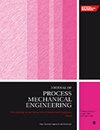An experimental investigation of single- and two-phase flow in copper and aluminum microchannel heat sinks
IF 2.2
4区 工程技术
Q2 ENGINEERING, MECHANICAL
Proceedings of the Institution of Mechanical Engineers, Part E: Journal of Process Mechanical Engineering
Pub Date : 2024-07-25
DOI:10.1177/09544089241262957
引用次数: 0
Abstract
In this study, single- and two-phase flow and heat transfer characteristics in copper and aluminum heat sinks were investigated experimentally. Deionized water was used as the working fluid in the experiments. Two-phase flow tests were performed at low vapor qualities (∼0.1). Each heat sink has a square shape of 20 mm × 20 mm. Heat sinks have 15 parallel microchannels. The hydraulic diameters of the channels range from 400 to 500μm, and their aspect ratios range from 0.4 to 2.5. The effects of material and aspect ratio on two-phase flow were studied. Experimental Nu values for single-phase flow were found to vary with an increasing trend between 4.6 and 7.2 values. The data overlap with the data obtained from the Sieder-Tate correlation for Re > 280. For Re < 280, the difference reaches 25%. The pressure drop in two-phase flow is 2.5 times higher than that measured in single-phase flow. The heat transfer coefficients of two-phase flow decreased with increasing the degree of vapor quality and increased with increasing mass flow rate. Heat transfer coefficients were found to be higher for 2.5 aspect ratio than coolers with similar hydraulic diameters. Additionally, the heat transfer coefficients of the copper heatsink were higher than those of aluminum.铜和铝微通道散热器中单相流和两相流的实验研究
本研究通过实验研究了铜和铝散热器中的单相和两相流动及传热特性。实验中使用去离子水作为工作流体。两相流试验在低蒸汽品质(∼0.1)下进行。每个散热器都是 20 毫米 × 20 毫米的正方形。散热器有 15 个平行的微通道。通道的水力直径在 400 至 500 微米之间,长宽比在 0.4 至 2.5 之间。研究了材料和长宽比对两相流的影响。实验发现,单相流的 Nu 值在 4.6 到 7.2 之间呈上升趋势。在 Re > 280 时,这些数据与通过 Sieder-Tate 相关性获得的数据重叠。在 Re < 280 时,差异达到 25%。两相流的压降是单相流的 2.5 倍。两相流的传热系数随蒸汽质量度的增加而降低,随质量流量的增加而升高。研究发现,长径比为 2.5 的冷却器的传热系数高于水力直径相似的冷却器。此外,铜散热器的传热系数高于铝散热器。
本文章由计算机程序翻译,如有差异,请以英文原文为准。
求助全文
约1分钟内获得全文
求助全文
来源期刊
CiteScore
3.80
自引率
16.70%
发文量
370
审稿时长
6 months
期刊介绍:
The Journal of Process Mechanical Engineering publishes high-quality, peer-reviewed papers covering a broad area of mechanical engineering activities associated with the design and operation of process equipment.

 求助内容:
求助内容: 应助结果提醒方式:
应助结果提醒方式:


